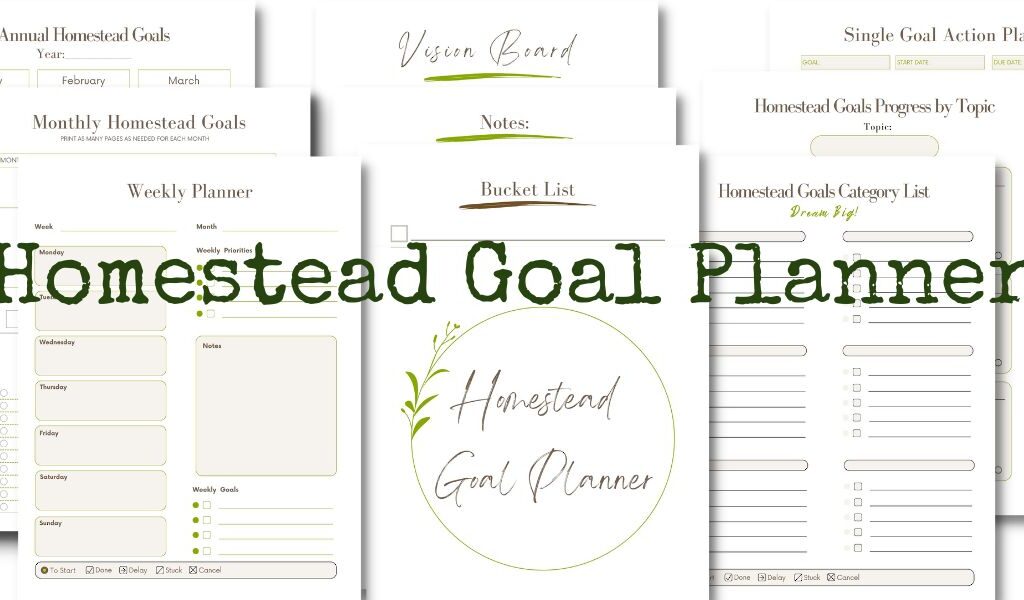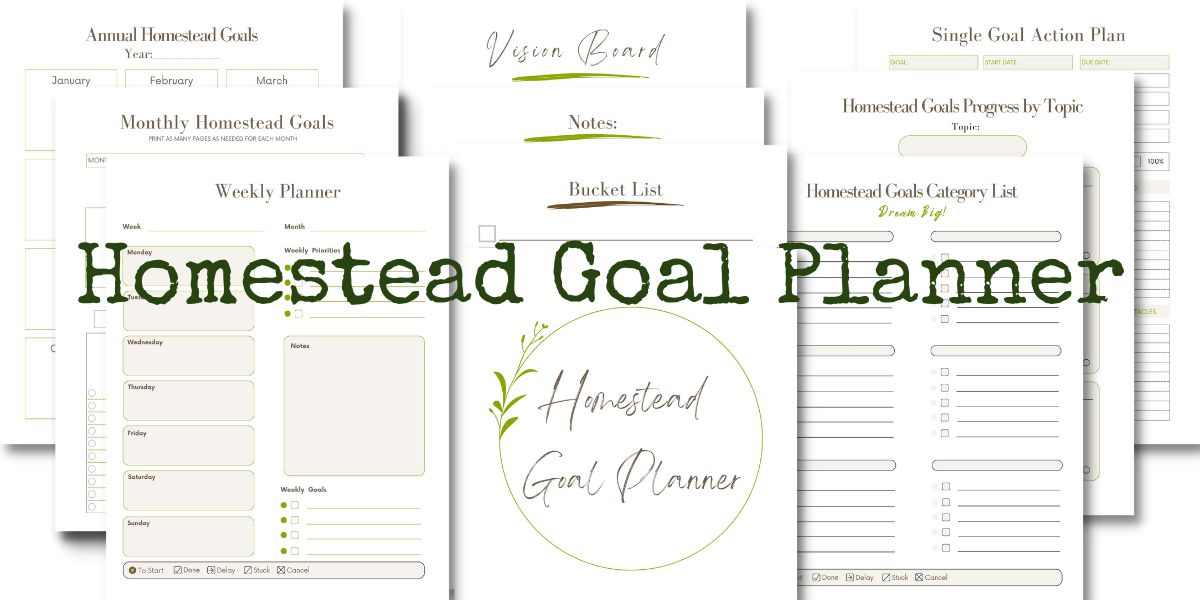Setting goals is a great way to improve self-sufficiency, productivity, and overall quality of life on your homestead.
Whether you’re an old-timer with decades of experience, or just dipping your toe in the waters of homesteading, it’s never too late to start setting meaningful and achievable goals.

Here are 10 basic steps to setting actionable and attainable goals for your homestead.
Table of Contents
- Define Your Vision
- Identify Key Areas
- Prioritize
- Set Specific Goals
- Consider Short, Medium, and Long-term Goals
- Break them into Actionable Steps
- Track Your Progress
- Continuously Evaluate and Adjust
- Seek Support and Accountability
- Celebrate the Achievements and Milestones
- Conclusion
- FAQs
**DISCLAIMER**This blog post contains educational content related to finances and homesteading. While I’ve made every effort to provide accurate and valuable information, I am not a financial professional. You should consult with a financial advisor or expert who can consider your unique individual circumstances before making any financial decisions. The insights shared in this blog post are based on my own experiences and research, and should not be considered as a replacement for personalized financial advice.
Define Your Vision
It’s important to clarify exactly what you want to achieve on your homestead. This might include choosing to live sustainably, growing a garden, raising livestock, living off-grid, etc. Read 12 Questions to Ask Before You Start Homesteading to learn specific questions that will help you with your brainstorming.
Be specific about what you envision. Find inspiration by researching. Read books and articles, watch videos, or listen to podcasts. Visit other homesteads or places related to the activities you wish to purse on your homestead. The more informed you are, the more realistic goals you’ll be able to set.
Record your thoughts and aspirations. Write down your Why to keep the vision fresh in your mind.
Use a vision board, journaling, mind-mapping, or a similar way of envisioning what you wish to accomplish on your homestead. Seek inspiration from others, especially those who will be homesteading with you. Practice visualizing your goals successfully completed.

Remember that your vision will change over time. Revisit your vision and goals yearly, or whenever something in life happens that calls for a change.
Identify Key Areas
Break down your vision list into categories. These might include: food production, infrastructure, water management, self-sufficiency, or other areas that align with your homestead’s current needs. Breaking down your goals by topic can help you focus on each particular task.
Prioritize
Once you’ve identified your key areas, prioritize which need to be accomplished first, or in tandem with others. Consider factors such as time, available resources, and your skill level.
You may wish to organize them by month or season. Or perhaps, most urgent to least urgent. Use a method that will best help you focus your efforts and allocate your resources effectively.
Consider Short, Medium, and Long-term Goals
Different goals require different time frames. Short-term goals are typically achieved within a few weeks to a few months. Medium-term goals are a year or two, and long-term goals usually span the course of several years to accomplish.
For instance, one of our homestead goals is to raise beef cattle. It’s one of our longest goals. We’ve set out the steps to setting up pasture, shelter, and all the things for raising cattle. The first step of the goal was determining where the pasture would be located when we purchased our land. Next came fencing, then establishing good grazing plants in the pasture. We revisit this goal every December and plan the next steps for the upcoming year.
We keep a record of our goals over the years. It helps to have a reference to look back and evaluate when and where steps were taken to accomplish those goals.
Set Specific Goals
Within each key area you’ve established, set specific, measurable goals.
There are many types of goal-setting techniques. A popular technique is using SMART goals. Other approaches you might consider are: Habit Stacking, Backward Planning, bullet journaling, and milestone tracking.
My Homestead Goal Planner has everything you need to plan your homesteading goals. From vision board to annual, monthly, and weekly planners, action plans and a bucket list, you can put all of your goals in one place for easy reference.
It’s available to purchase in my Etsy shop HomesteadByDesign.

Break Your Goals into Actionable Steps
Once you’ve chosen a type of goal-setting technique, break down each goal into manageable steps.
For example, my goal could be: Grow enough tomatoes for canning 21 quarts of sauce. My actionable steps would be:
- Start seedlings from seed.
- Plant the seedlings and maintain their growth.
- Harvest the tomatoes.
- Can the tomato sauce.
The seed-starting step can be broken down into a manageable goal like this:
- Look at my gardening journal and harvest tallies from previous years to note how many plants I need for the upcoming growing season.
- Inventory my seed stash, then purchase any additional seeds I may need.
- Set up the grow lights and heat mats, purchase seed-starting medium if needed.
- On the selected date, start the seeds, track their growth, water, and adjust lighting as needed.
- When the seedlings are the correct size, harden off outside.
- Plant seedlings.
The other three steps of the larger goal could be broken down into smaller steps like the example.
Track Your Progress
Tracking your progress is an essential component of goal setting, especially for homesteaders. It helps you set benchmarks, improve efficiency, and provide valuable data for future projects.
It also enables you to work with others effectively by making sure everyone is on the same page and working toward your common goals.

Having your goals written down and scheduled builds accountability and can inspire you when your motivation is low, or a task seems daunting.
By tracking your successes, you can celebrate your small victories along the way to achieving your larger goals.
Continuously Evaluate and Adjust
Make sure to take time to evaluate your progress. It will help you measure your success and identify challenges you may not have anticipated when you started.
For example, you could have weekly or monthly family meetings, conduct an end-of-project evaluation, create a simple checklist, or choose another method that works for you.
Keep in mind your physical and mental health too. Overworking and overplanning are unhealthy practices that could lead to homesteading burnout or worse. Make adjustments to your goals as needed to maintain a balanced and sustainable lifestyle that aligns with your Why.
Make allowances for possible economic conditions changing such as a job loss, inflation, or similar events. Many people keep a financial savings account with several months if not years’ worth of money to sustain them through difficult times. Paying down and/or eliminating debt also frees you up for when finances get tight. Our Frugal Finances page has plenty of tips to help you out.
One of the hallmarks of modern homesteading is building resiliency. Adjusting to changing circumstances and realigning your goals will create a more satisfying homesteading experience. There have been several times when we’ve had to push back a completion date due to weather, health, or a change in priorities. Adapting to challenges is an intangible skill that is necessary for any homesteader.
Seek Support and Accountability
The homesteading community is active, dynamic, and growing. Reach out to others in your community, find online groups and forums, or seek out a mentor. Sharing your goals with others can give you valuable guidance, encouragement and keep you motivated.

Celebrate the Achievements and Milestones
Whether small or large, celebrate your successes! Every positive step and goal accomplished creates a happier homestead.
When I’ve successfully finished a goal, I like to look back and see how it aligns with our Why. I enjoy celebrating how we’re another step closer to our larger goals and living the lifestyle we’ve chosen.
Remember that completing and celebrating your goal is just as important as brainstorming and starting it. Isn’t that why we set goals to begin with?
Conclusion
Turning your homesteading dream into an action-planned set of goals will set a strong foundation for your homestead.
Remember that setting goals for your homestead is a dynamic process. As you gain new experiences and build your skills, know that you’ll have to adapt and change at times. Stay flexible, learn new things, and celebrate completing your homesteading goals.

FAQ
Why should I set goals for my homestead?
If you’re still on the fence about whether goal-setting is worth the effort, my article 7 Reasons Why You Should Set Goals for Your Homestead will help you clarify your purpose for homesteading and set you up for choosing a successful path forward.
Can I use S.M.A.R.T. Goals for my homestead?
Yes! The S.M.A.R.T. method is extremely popular for many reasons. It can easily be adapted to homesteading. Download my FREE planning worksheet I created for people who prefer the S.M.A.R.T. method.
What are some goals I should set for my homestead?
Every homestead is unique. Knowing why you want to homestead, and what you want to do on your homestead will help you answer that question. Review the first few sections of this article and visit the related links to get a better idea of how you’d like to live on your homestead.
Need a Goal Planner?
My Homestead Goal Planner has everything you need to plan your homesteading goals. From vision board to annual, monthly, and weekly planning pages, action plans and a bucket list, you can put all of your goals in one place for easy reference. It’s available to purchase in my Etsy shop HomesteadByDesign.

[…] learning a new food preservation method, or building a new structure. Break down the list into seasonal goals so you can stay motivated while making steady progress throughout the […]